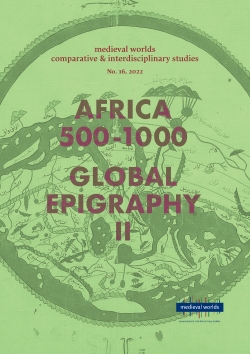Isabel Toral
S. 93 - 107
doi:
10.1553/medievalworlds_no16_2022s93
Verlag der Österreichischen Akademie der Wissenschaften
doi:
10.1553/medievalworlds_no16_2022s93
Abstract:
The Islamic conquest of the seventh century marked the beginning of a process that pulled the Far and Central Maghreb into the emerging Islamic world. This process was, however, not straightforward. Step by step, commercial, political and intellectual bonds linked the Maghreb with the Middle Eastern centers, while religious missionaries and political dissidents arrived there and sought for adepts amongst the newly converted population. Umayyads and Fatimids used this territory to fight their battles. The conflicts between these rival regional macro-powers forced the Berber imamates to increase their dependence on the Western Umayyads in Al-Andalus. Economically the Maghreb had become part of a transregional commercial network (slave- trade) and eventually became part of the Islamicate world sharing legal practices, religious doctrines and globally connected scholarly elites. The growing influence of Maliki scholars and practices prepared the terrain for the adoption of the Maliki legal school and the marginalization of local forms of Islam. Finally, the Maghreb became part of a “Sunni” mainstream Islam throughout the tenth and eleventh centuries.
Central and Far Maghreb (modern Algeria and Morocco); arḍ al-Barbar (land of the “Berbers”); “Islamization”, “Arabization”; Umayyad caliphate; Khārijism, Idrisids, Ibāḍite communities; Kharijites; Shiites; Ismailites
Published Online:
2022/06/30 06:39:16
Object Identifier:
0xc1aa5576 0x003d894f
Rights:All rights reserved.For questions regarding copyright and copies please contact us by email.
medieval worlds provides a forum for comparative, interdisciplinary and transcultural studies of the Middle Ages. Its aim is to overcome disciplinary boundaries, regional limits and national research traditions in Medieval Studies, to open up new spaces for discussion, and to help developing global perspectives. We focus on the period from c. 400 to 1500 CE but do not stick to rigid periodization.
medieval worlds is open to submissions of broadly comparative studies and matters of global interest, whether in single articles, companion papers, smaller clusters, or special issues on a subject of global/comparative history. We particularly invite studies of wide-ranging connectivity or comparison between different world regions.
Apart from research articles, medieval worlds publishes ongoing debates and project and conference reports on comparative medieval research.
Editorial
Ingrid Hartl and Walter Pohl
Africa 500-1000. New Perspectives for historical and archaeological research
Guest editors: Roland Steinacher, Paolo Tedesco and Philipp Margreiter
Africa 500-1000. Introduction
Roland Steinacher and Philipp Margreiter
A New Age of Saint Augustine? Antoine-Adolphe Dupuch, François Bourgade, and the
Christians of North Africa (1838-1858)
Bonnie Effros
A Subaltern’s View of Early Byzantine Africa?: Reading Corippus as History
Andy Merrills
Islamizing Berber Lifestyles
Elizabeth Fentress
The Umayyad Dynasty and the Western Maghreb. A Transregional Perspective
Isabel Toral
Maritime Trade from 3rd/9th-century Ifrīqiya: Insights from Legal Sources
Antonia Bosanquet
Africa’s Transitions to the Middle Ages
Paolo Tedesco
Global Epigraphy II. Perception and Representation of the Foreign
Guest editor: Andreas Rhoby
Introduction
Andreas Rhoby
Identification by Architectural Shape.
Sarcophagi of Indigenous People and Foreigners in Roman Imperial Lycia
Oliver Hülden
Imaginations of Barbarians and Barbarian Lands in the Latin Verse Inscriptions
Peter Kruschwitz
“Foreign(er)”, “Strange(r)” and “Extraordinary”:
xenos and its Meanings in Byzantine (Metrical) Inscriptions
Andreas Rhoby
From Genova to Yangzhou? Funerary Monuments for Europeans
in Yuan China and their Paleographic Analysis
Eva Caramello and Romedio Schmitz-Esser
Alieness in Inscriptions and Alien Inscriptions.
Alterity and Strangeness as Reflected in Pre-Modern Inscriptions from Central Europe
Andreas Zajic
Individual Article
Creolisation and Medieval Latin Europe
Bernard Gowers




 Home
Home Print
Print
 References
References
 Share
Share
